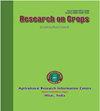旁遮普省中部平原地区灌种对晚播小麦生长和产量的影响
Q3 Agricultural and Biological Sciences
引用次数: 0
摘要
种子萌发不良影响晚播条件下作物的生长和产量。因此,本研究在印度阿姆利则哈尔萨学院农业部学生研究农场进行了2020-21年和2021-22年拉比期间灌种对晚播小麦生长和产量的影响研究。试验采用随机分组设计,包括10个处理和3个重复。试验选用小麦晚播品种pbw752。结果表明:灌种处理对试验重、收获指数和蛋白质含量影响不显著,但对株高、干物质积累量、叶面积指数、分蘖数、有效分蘖数、穗粒数、穗粒数、生物产量、籽粒产量和秸秆产量影响显著。在10,000 ppm的硝酸钾灌种处理中,籽粒产量最高(34.9 q/ha),生物产量最高(87.67 q/ha),每米行有效分蘖数最高(50.30),穗长最高(9.50 cm),穗粒数最高(38.20)。本研究结果使我们得出结论,在晚播条件下,灌种可以提高小麦籽粒产量。本文章由计算机程序翻译,如有差异,请以英文原文为准。
Effect of seed priming on growth and yield of late sown wheat (Triticum aestivum) in central plain region of Punjab
Poor seed germination affects growth and yield of crop under late sown conditions. Therefore, this research was conducted to study the effect of seed priming on growth and yield of late sown wheat at student's Research Farm, Department of Agriculture, Khalsa College, Amritsar, India during rabi 2020-21 and 2021-22. The experiment was set up in a randomised block design which included 10 treatments and three replications. Late sown variety PBW 752 of wheat was used during experiment. The results showed that using different treatments of seed priming had no significant effect on parameters i.e. test weight, harvest index and protein content but other parameters like plant height, dry matter accumulation, leaf area index, number of tillers, number of effective tillers, spikelets per spike, grains per ear, biological yield, grain yield and straw yield were significantly affected by seed priming. In the treatment of seed priming with potassium nitrate @ 10,000 ppm recorded highest grain yield (34.9 q/ha), biological yield (87.67 q/ha), effective tillers per metre row (50.30), spike length (9.50 cm) and number of grains per spike (38.20). The results of this study allowed us to draw the conclusion that wheat grain production can be improved by seed priming under late sown conditions.
求助全文
通过发布文献求助,成功后即可免费获取论文全文。
去求助
来源期刊

Research on Crops
Agricultural and Biological Sciences-Soil Science
CiteScore
1.50
自引率
0.00%
发文量
93
审稿时长
1 months
期刊介绍:
The Research on Crops is a peer-reviewed journal publishing original research papers, review articles and short communications in English on all basic and applied aspects of crop sciences, agricultural water management, agro-climatology, agroforestry, agronomy, crop production, crop protection, cropping systems, food science & technology, genetics & plant breeding, horticulture, plant & soil science, plant biotechnology, plant nutrition, post-harvest management of crops, seed science, soil management & tillage, vegetables, weed science, agricultural engineering, agri-business, agricultural economics and extension, etc. The aim of the journal is to provide a forum for the scientific community to publish their latest research findings.
The manuscripts submitted for publication should not contain data older than 4 years on the date of submission.
The articles submitted for publication in this journal should not be submitted elsewhere simultaneously for publication in another journal. These should not carry any copyright material without prior permission of copyright holder.
The articles should present a complete picture of the investigation made and should not be split into parts.
There is no prescribed limit regarding the number of pages in case of full-length articles. However, the authors are advised to keep the length of their articles from 4 to 10 full printed pages of the journal.
The articles should be divided into the sub-sections: ABSTRACT, INTRODUCTION, MATERIALS AND METHODS, RESULTS AND DISCUSSION, CONCLUSIONS, and REFERENCES. Tables and figures should be appended separately at the end.
 求助内容:
求助内容: 应助结果提醒方式:
应助结果提醒方式:


